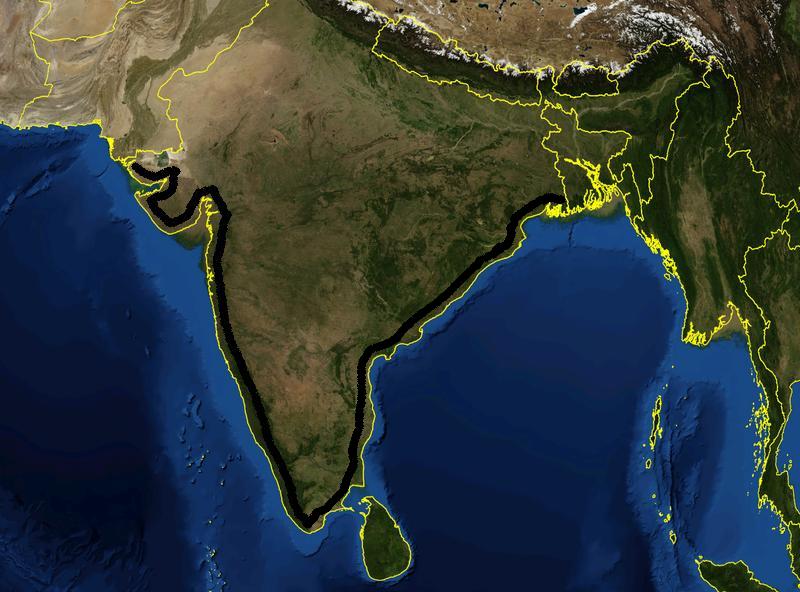The Indian coastline which is 7516.6 km long covers 6100 km of mainland coastline along with the Andaman, Nicobar and the Lakshadweep islands. The coastline of India touches 13 states and Union Territories. The western coastal plains are along the Arabian Sea whereas the eastern coastal plains are located along the Bay of Bengal.
Physical features of India are a very important segment in the Geography section of the UPSC syllabus. In this article, we talk in brief about the coastal plains in India. Candidates appearing for the IAS Exam can also download the notes PDF at the end of this article.
| Aspirants should begin their preparation by solving UPSC Previous Year Question Papers now!!
To complement your preparation for the upcoming exam, check the following links: |

Coastal Plains in India
India is a country that is surrounded by the sea on three of its sides. The coastal plains in India are along the west and east of the country. Extending up to 7516.6 km, the coastal plains in India are of two types:
- Eastern Coastal Plains of India
- Western Coastal Plains of India
Eastern Coastal Plains of India
The eastern coastal plains stretch from West Bengal in the north to Tamil Nadu in the south and pass through Andhra Pradesh and Odisha. Deltas of the rivers Mahanadi, Krishna, Godavari and Cauveri are present in the eastern coastal plain. The deltas are very fertile and productive for agriculture. Therefore, the delta of the River Krishna is called the ‘Granary of South India‘. The Eastern coast is again divided into three categories:
- Utkal coast: Extending between the Chilika Lake and Kolleru Lake, they are much wider than the western coastal plains and undergo immense rainfall. Some of the crops that are cultivated here are rice, coconut and banana.
- Andhra coast: Extending between the Kolleru Lake and Pulicat Lake, the Andra coast forms a basin area for the Krishna and the Godavari rivers.
- Coromandel coast: The Coromandel coast extends between Pulicat Lake and Kanyakumari in Tamil Nadu. This Indian coastline remains dry in summer and receives rainfall during the winters due to the north-east monsoons.
Western Coastal Plains of India
Western Coastal Plains stretches from Kerala in the south to Gujarat in the north passing through Karnataka, Goa and Maharashtra. The western coastal plains stretch for 1500 km north to south and its width ranges from 10 to 25 km. The West Continental Shelf is at its widest off the Bombay coast. This place is rich in oil. Along the Malabar Coast, there are many beautiful lagoons which makes the place a tourist destination. The western coast is narrower than the eastern coast.
The western coast is further divided into four categories:
- Kachchh and Kathiawar coast: Kachchh, formerly a gulf is formed by the deposition of silt by the Indus. The area of Kachchh is covered with shallow water during the monsoons and is divided into Great Rann in the north and Little Rann in the east. Whereas, Kathiawar is situated to the south of Kachchh.
- Konkan coast: It extends between Daman in the north to Goa in the south. Rice and cashew are the two important crops of this region.
- Kanada coast: It extends between Marmagaon and Mangalore and is rich in iron deposits.
- Malabar coast: Extending between Mangalore to Kanyakumari, the Malabar coast is relatively broad. This region also consists of lagoons running parallel to the coast in southern Kerala.
Significance of Indian Coastlines
The coastlines of India extends up to 7516.6 km including the island groups Andaman and Nicobar and Lakshadweep. As a result, the areas that are covered under the Indian coastlines enjoys a favourable climate with no extreme temperature which is ideal for human development. Some of the major significance of the coastal plains in India are mentioned below:
- The coastal plains in India are mostly covered by fertile soils which are best for cultivations. Rice is the major crop that is cultivated in these regions.
- The big and small ports along the Indian coastlines helps in carrying out trade.
- The sedimentary rocks of these coastal plains are said to contain large deposits of mineral oil which can be used as a source of marine economy.
- Fishing has become an important occupation of the people living in coastal areas.
- The coastal plains in India are rich in coastal and marine ecosystems which also include a wide range of mangroves, coral reefs, estuaries and lagoons serving as great tourism potential.
The geographical distribution of India is an important part to cover for UPSC 2024. Several questions can be asked from this section in the UPSC prelims as well as in the IAS mains exams.
Coastal Plains in India:- Download PDF Here
Frequently asked Questions about Coastal Plains
What are the coastal plains of India?
Why are the coastal plains important?
Related Links
| IAS Salary | UPSC Syllabus |
| Current Affairs Quiz 2023 | Expected Cutoff |
| Panchayati Raj in India | Panipat War 3 |
| Railway Protection Force | UPSC Calendar 2024 |
Comments